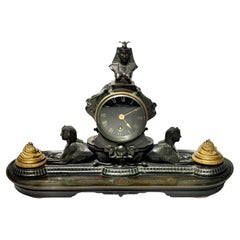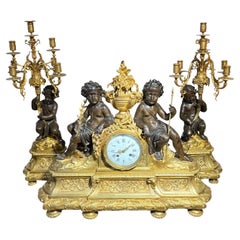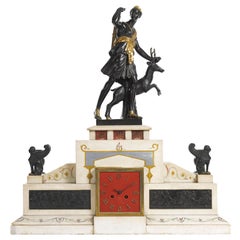Want more images or videos?
Request additional images or videos from the seller
1 of 21
Greek Revival 19 century Porcelain Mantle Clock and Vases Garniture
$5,500List Priceper set
About the Item
- Dimensions:Height: 14.25 in (36.2 cm)Width: 9 in (22.86 cm)Depth: 5 in (12.7 cm)
- Sold As:Set of 3
- Style:Egyptian Revival (Of the Period)
- Materials and Techniques:
- Place of Origin:
- Period:
- Date of Manufacture:1880s
- Condition:Repaired: One Vase is professionally restored and looks perfect at this time. Top of the clock has a hole which indicates that there might have been a small finial there that is missing. Missing striking bell and pendulum. Wear consistent with age and use. Minor losses.
- Seller Location:New York, NY
- Reference Number:1stDibs: LU881932115772
About the Seller
5.0
Vetted Professional Seller
Every seller passes strict standards for authenticity and reliability
Established in 1890
1stDibs seller since 2009
265 sales on 1stDibs
Typical response time: 4 hours
Authenticity Guarantee
In the unlikely event there’s an issue with an item’s authenticity, contact us within 1 year for a full refund. DetailsMoney-Back Guarantee
If your item is not as described, is damaged in transit, or does not arrive, contact us within 7 days for a full refund. Details24-Hour Cancellation
You have a 24-hour grace period in which to reconsider your purchase, with no questions asked.Vetted Professional Sellers
Our world-class sellers must adhere to strict standards for service and quality, maintaining the integrity of our listings.Price-Match Guarantee
If you find that a seller listed the same item for a lower price elsewhere, we’ll match it.Trusted Global Delivery
Our best-in-class carrier network provides specialized shipping options worldwide, including custom delivery.You May Also Like
19th Century Egyptian Revival Green Onyx and Bronze Garniture Mantle Clock
Located in Dublin 8, IE
19th Century Egyptian Revival green onyx and bronze garniture mantle clock with two obelisks, with the clock mounted and flanked by ormolu sphinxes and all parts of the set featuring...
Category
Antique 19th Century European Egyptian Revival Mantel Clocks
Materials
Onyx, Bronze, Ormolu
$8,557
H 15.5 in W 20 in D 5 in
Egyptian Revival Bronze and Marble French Mantle Clock
By Mermod Jaccard & Co.
Located in Bronx, NY
This wonderful 1920s Egyptian Revival clock is surmounted with an Assyrian style lamassau (human headed winged lion) and flanked by a pair of re...
Category
Early 20th Century French Egyptian Revival Mantel Clocks
Materials
Belgian Black Marble
French 19C Japy Freres & Red Sevres Porcelain Mantle Clock with Garniture Set
By Japy Frères, Phillipe Mourey, Manufacture Nationale de Sèvres
Located in Dallas, TX
PRESENTING A STUNNING mid to late 19C French Japy Freres & Red/Magenta Sevres Porcelain Mantle Clock with Garniture Candlestick Ewers.
The clock movement is by the famous Parisienne Clockmaker … ‘Japy Freres’ and the clock dial has the marks for “JAY” (short for Japy Freres) & “Paris” on the dial face.
The clock mechanism and clock face/dial have matching serial numbers of “7225”. The movement also has the numbers: “5 – 2”.
The clock face/dial also has the initials: “D.H.”.
The gilt ormolu clock case is gilt spelter and is signed on the rear base, for having been made by “P.H. Mourey” of Paris, who worked with and for ‘Japy Freres’, towards the end of the 19th Century.
The signature of ‘Mourey’ also bears the numbers “85” … probably for 1885, but could also be the serial number.
Taking into account Mourey’s historical association with Japy, being late 19th Century, we are leaning heavily towards this being the date of manufacture i.e. 1885.
The Clock has RARE red/magenta Sevres hand-painted porcelain paintings/additions, to include:-
(i) a 2 handled and lidded urn on the crown with pointed flame finial,
(ii) a pair of bulbous urns either side of the main body and clock face,
(iii) the clock face and dial itself and
(iv) a flat rectangular medallion on the front base.
The crown urn and the base medallion both have similar themes, but different painted scenes, depicting French rural countryside scenes with cottages, rivers and bridges.
The porcelain urns on the sides, likewise have hand-painted images of a young boy, in rustic period attire on the right and a young girl on the left.
None of these paintings appear to be signed.
The clock case has GLORIOUS detail to it, with scrolls, ribbons, vines, grapes and Corinthian columns.
The clock sits on a custom made gilt wood and burgundy velvet plinth, that is original to the piece and was a common accent with ‘Japy Freres Clocks’, when originally retailed in their Paris shop.
The rear of the clock is plain and the perspex/clear resin plate insert, is a new addition, but a nice addition, in that it allows one, to view the movement and pendulum works.
The clock is an 8 day movement with a strike on the hour and half hour. The clock face has 2 winding holes … one for the pendulum movement and the other for the striking chime/ring.
Unlike British clocks this clock does not have a long musical chime … it is a simple ‘single strike’ on the half hour.
The red/magenta Sevres porcelain clock face/dial is in SUPERB condition. Roman numerals with gilt accents and a hand-painted circular wreath/bouquet of spring flowers on the center section.
To complete the set, we have a matching pair of gilt ormolu spelter and hand-painted red/magenta Sevres porcelain Ewers … which can hold a single candle each.
The porcelain urns on the central section, have hand-painted images of a young lady in rustic period attire … fishing on the riverbank on the right and a young man playing the flute in the countryside on the left.
The front base medallions on each ewer have hand-painted wreaths/bouquets of spring flowers.
The clock facing side of the porcelain urn on each Ewer, has a brass ormolu applique head, of the Greek god of wine-making, orchards and fruit, vegetation, fertility, festivity, insanity, ritual madness, religious ecstasy, and theatre, namely, Dionysus.
The plinths are signed on the rear top left corner, and we think they read: “R.P. Unfaut”. They also bear the numbers “61” and “69”, Again, possibly for 1861 and 1869, but here we think it is more likely they are serial numbers, as it is highly unlikely that a matching pair were made 8 years apart!
Whilst we cannot find any information on ‘R.P. Unfaut’, we can only guess that he/she/they worked with, or for, ‘Japy Freres’, as these ewers are unmistakably, a ‘superb’ match for the clock!
The style, subject matter, gold banding and edging, around the paintings, are virtually ‘identical’ to the same decorations on the clock’s porcelain paintings.
The Ewer on the left (with the boy playing the flute) appears to have a faded signature on the gold border of the painting towards the base and we think it is the signature of ‘Alexandre Evariste Fragonard’ …. one of the best known artists attached to Sevres in the mid 19th Century … meaning, that these Ewers were probably made circa 1845-50.
The quality and detail to these 2 paintings is classic Fragonard!
We are of the opinion, therefore that these garnitures, were made circa 35/40 years before the clock, as Mourey was prevalent with Japy around 1880 – 1900.
The clock paintings are of a very similar, rustic ‘Fragonard Style’ subject matter and although unsigned, could possibly have been painted by a Sevres artist, to replicate the Fragonard paintings...
Category
Antique 19th Century French Rococo Revival Mantel Clocks
Materials
Ormolu
$12,000 / set
H 18.25 in W 13.5 in D 6 in
Egyptian influenced clock garniture, 19th Century.
Located in Brighton, Sussex
A very imposing 19th Century Egyptian influenced mantle clock garniture, the black and rouge marble having wonderful patinated bronze mounts depicting Egyptian sphinx like mounts to ...
Category
Antique 19th Century French Egyptian Revival Mantel Clocks
Materials
Belgian Black Marble, Bronze
French Egyptian Revival Patinated Bronze and Marble Mantle Clock
By Bigelow Kennard & Co.
Located in Bronx, NY
The clock having domed trapezoidal case, dome with bronze relief to front depicting a partial gilt Egyptian goddess, Isis, flanked by cobras and lotus scrolls, red marble ribbed columns to sides, clock face with gilt egg-and-dart border, gilt hands and mounts, clock face engraved BIGELOW KENNARD & CO. BOSTON, double-barrel clock movement by Achille Brocot, down to chained sphinx protruding from lower case, raised on stepped plinth. This vintage mantle clock...
Category
Antique Late 19th Century American Egyptian Revival Mantel Clocks
Materials
Marble
Garniture, clock and candelabra. Bronze, porcelain. France, 19th century.
Located in Madrid, ES
Garnish with clock and candelabra in porcelain and gilt bronze. France, 19th century.
Mechanism in perfect working order.
Fireplace garnish composed of a clock and two five-light candelabras, all three pieces made by combining gilt bronze, with relief elements and round bulges and cold-chiseled details, and porcelain decorated with low-temperature enamels, including gold enamel. The porcelain pieces follow models from the Sèvres National Manufacture of the 18th century, with large pictorial cartouches on a cobalt blue background adorned with golden plant motifs. The set follows a historicist design that combines baroque and neoclassical elements with enamelled scenes of Rococo inspiration, representing landscapes and scenes with mythological themes alluding to the arts and the goddess Venus. The clockwork is stamped “Chles. MT”, with serial number 17420. The main glazed porcelain plates are signed DP Boncher. The clock follows an architectural structure, with an oval base with a prominent front in plan, raised on four molded feet in the shape of a top, on which a large ornamental vase is placed. This plinth has a distinct pinto and, above it, a main body as a façade, with a circular pediment that houses the clock face. This includes black enamelled Roman numerals on white medallions with a gold border, arranged around the central representation of a putti reclining among clouds, holding a floral garland and accompanied by musical instruments. Among the medallions that house the numbers, a small jeweled decoration that evokes pearls and embedded rubies, which is echoed in the secondary areas of the body of the piece and also the vase, always combined with delicate golden filigrees.
On both sides of the sphere are two female portraits of ladies from the 18th century, in oval frames. Below, a classically inspired scene with a muse holding musical instruments, probably Euterpe or Erató, accompanied by a putti reading a sheet of music. On the sides of the clock body, two large curved rectangular plates house highly pictorial enameled landscapes, worked with the same miniaturist precision as the rest of the enameled cartouches. These are landscapes of romantic heritage, again inspired by the 18th century, with ideal settings for a twilight atmosphere, featuring classical ruins. The vase that tops the body of the clock has a hemispherical tank, shoulders ending in an edge, an openwork truncated conical neck, which opens smoothly towards the shoulders, and a domed lid, also openwork. The handles are figurative, in bronze, with two female sisters crowned with flowers, of clear Greco-Latin inspiration, worked in a round shape. In the tank, the vase houses two enameled porcelain cartouches, the front one with two putti and a dove - a symbolic allusion to Venus - and the back one with musical instruments. The design of the clock is completed by two thick bronze S-shaped plant braces, under the vase, and counter moldings and plant motifs cast in relief and cold chiseled, combining matte and polished finishes. The candelabras follow a similar design, with large vases of neoclassical design on pedestals, in this case cylindrical, raised on four low feet of turned design. The bases house porcelain cartouches with scenes of putti related to the arts; In one of them we see two putti practicing painting, and in the other two others in a scene related to classical lyric poetry, with one putto writing while the other, holding a lyre, raises a laurel wreath above his head. The cartouches that occupy the front of the candelabra vases...
Category
Antique 19th Century French Neoclassical Revival Mantel Clocks
Materials
Metal, Bronze, Other
$39,496 / set
H 25.6 in W 23.63 in D 16.54 in
19th Century Black Forest Carved Mantle Clock Spill Vase Garniture Set
Located in Forney, TX
A magnificent antique Black Forest carved three piece mantel clock and garniture set. circa 1880
Swiss or German, late 19th century, a truly extraordinary work of art, exceptionally executed, intricately sculpted and finely detailed throughout, hand carved from a single block of wood, featuring a leaping stag deer over elaborate naturalistic foliage, a pair of pheasants with inset glass eyes, wooden dial with gilt incised Roman numeral hour markers and eight day time-and-strike movement, sculptural interwoven root carvings on a conforming molded edge base, flanked by a hunting dog and mountain rescue dog, both with inset glass eyes, retaining the original pressed glass spill vases.
A spill vase was typically kept on the mantelpiece and filled with spills, splints, or tapers used to transfer fire from the fireplace to candles, lamps, a pipe or a cigar.
Dimensions:
Complete: (approx/depending on setup)
20.25" Tall, 30" Wide, 7.5" Deep
Mantle / shelf clock:
20.25" High, 14" Wide, 7.5" Deep
Dog sculpture garniture:
13" High, 4.75" Wide, 4.25" Deep (each)
Great antique condition with beautifully aged warm rich dark patina. Minor wear consistent with age. Currently working and keeping good time, key and pendulum included. As with all antique clocks...
Category
Antique Late 19th Century European Black Forest Mantel Clocks
Materials
Glass, Wood
$14,500
H 20.25 in W 30 in D 7.5 in
Egyptian Revival Mantle Clock Retailed By Tiffany & Company
By L. Marti et Cie
Located in Essex, MA
A TIFFANY & CO. EGYPTIAN REVIVAL MANTLE CLOCK, AMERICAN, 1880s,
a bronze ormolu and marble clock made by L. Marti et Cie for Tiffany & Company, marked on clock face, "Tiffany & Co." ...
Category
Antique 1880s French Egyptian Revival Mantel Clocks
Materials
Marble, Bronze, Ormolu
Meissen porcelain 19th century mantle clock.
By Meissen Porcelain
Located in Brighton, Sussex
An impressive 19th Century Meissen porcelain mantle clock on stand. Depicting seated lovers with a garland of flowers. The white enamel clock face ...
Category
Antique 19th Century German Mantel Clocks
Materials
Porcelain
19C French Mantle Clock with Candelabra Garnitures by J. Marti (Paris)
By Marti
Located in Dallas, TX
PRESENTING A STUNNING Mid 19th Century French Slate & Bronze Mantel Clock by Marti with pair of slate and bronze candelabra’s as garnitures.
This ‘large’ mantle clock, was made circ...
Category
Antique Mid-19th Century French Neoclassical Revival Mantel Clocks
Materials
Slate, Brass, Bronze
$7,800 / set
H 26 in W 11.2 in D 6.8 in
More From This Seller
View All19th Century Egyptian Revival Bronze Mantel Clock
Located in New York, NY
Antique (late 19th century) Egyptian Revival period French empire style mantel clock in bronze with dark brown patina, retailed at Brown and Rogers of Providence, Rhode Island.
Category
Antique Late 19th Century French Egyptian Revival Mantel Clocks
Materials
Bronze
Large French Figurative Greek Revival Bronze Clock by Auguste Moreau
By Auguste Moreau
Located in New York, NY
Large antique (late 19th century) French figurative clock from the Greek Revival period depicting the goddess, Selene, after the original sculpture by Auguste Moreau (French, 1834-19...
Category
Antique Late 19th Century French Greek Revival Mantel Clocks
Materials
Bronze
19th Century French Ormolu Bronze Mantel Clock and Candelabra Garniture
Located in New York, NY
Magnificent antique (late 19th century) ormolu bronze garniture set in the Louis XVI style, including mantel clock with patinated seated putti and pair of candelabra. Clock made by ...
Category
Antique Late 19th Century French Louis XVI Mantel Clocks
Materials
Bronze
Large 19th Century Neoclassical Figural Bronze and Marble Mantle Clock
Located in New York, NY
Large 19th century neoclassical figural patinated with gilt highlight bronze and marble mantle clock depicting Diana The Hunter.
The marble is hand painted with classical decorations.
Category
Antique 19th Century Italian Neoclassical Mantel Clocks
Materials
Marble, Bronze
19th Century French Mantel Clock and Candelabra Garniture in Islamic Style
Located in New York, NY
French Mantel Clock and Candelabra Garniture in Islamic Style, circa 1880s. Clock measures 13.5 by 10.5 by 6 inches.
Category
Antique Late 19th Century French Islamic Mantel Clocks
Materials
Bronze
19th century French Bronze mounted Onyx Garniture Clock and Candelabra Set
Located in New York, NY
Very fine quality and unusual Antique (19th century) French Louis XVI style garniture including mantel clock and pair of two-light candelabra neoclassical style, finely crafted from ...
Category
Antique Late 19th Century French Louis XVI Mantel Clocks
Materials
Onyx, Bronze
Recently Viewed
View AllMore Ways To Browse
Antique Egyptian Vases
Mantle Garniture
Porcelain Mantle Clocks
Mantle Vase
19 Century French Vase
French Clocks Greek
White Marble Mantel Clock
19th Century French Bronze Dore Clock
1860 French Circa Mantel Clock
1910 Clock
Art Deco Marble Clocks
Unusual Antique Clocks
Champleve Clocks
Gilded French Clock
Art Deco French Mantel Clocks
Brass Mantle
Antique Metal Mantel Clocks
Gilt Bronze Figural Clock



